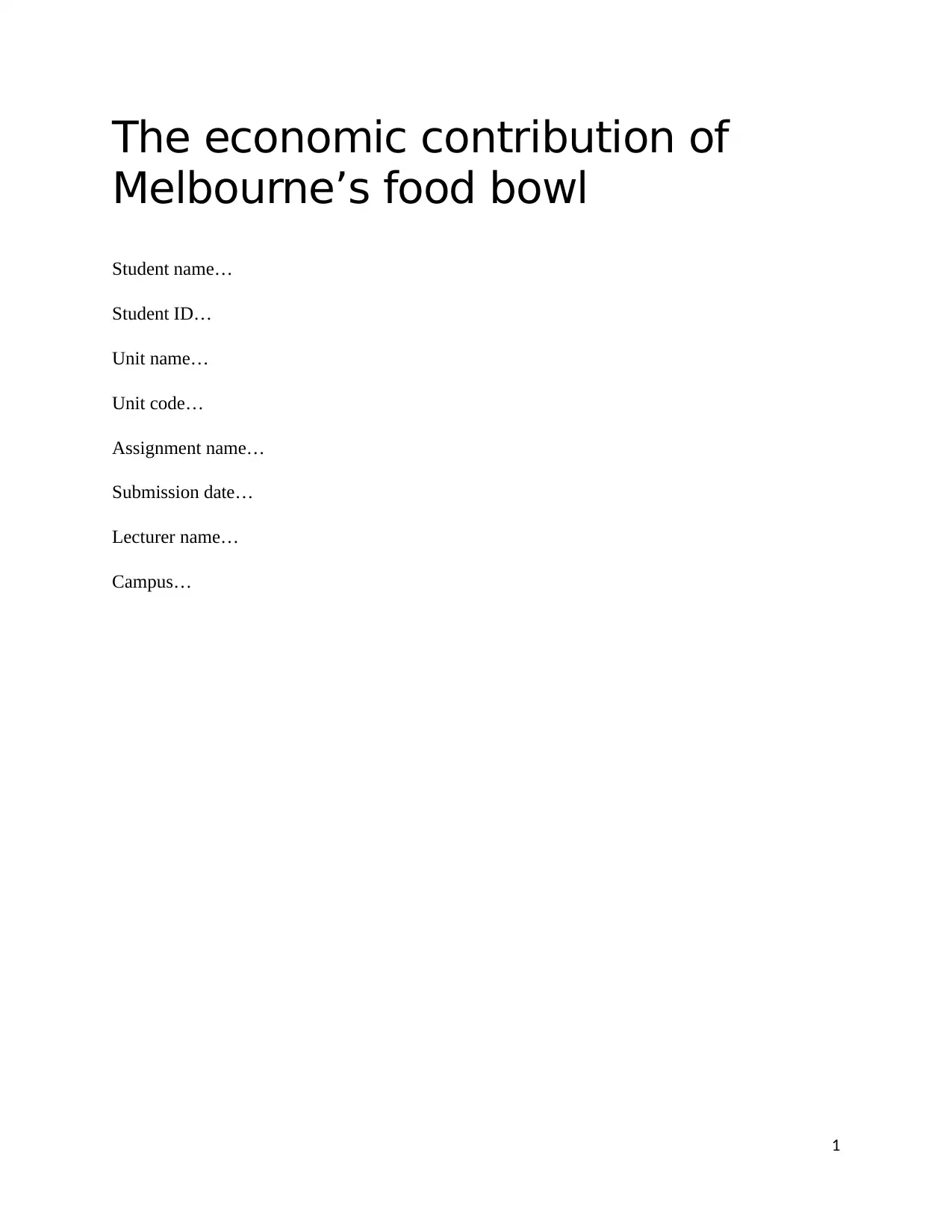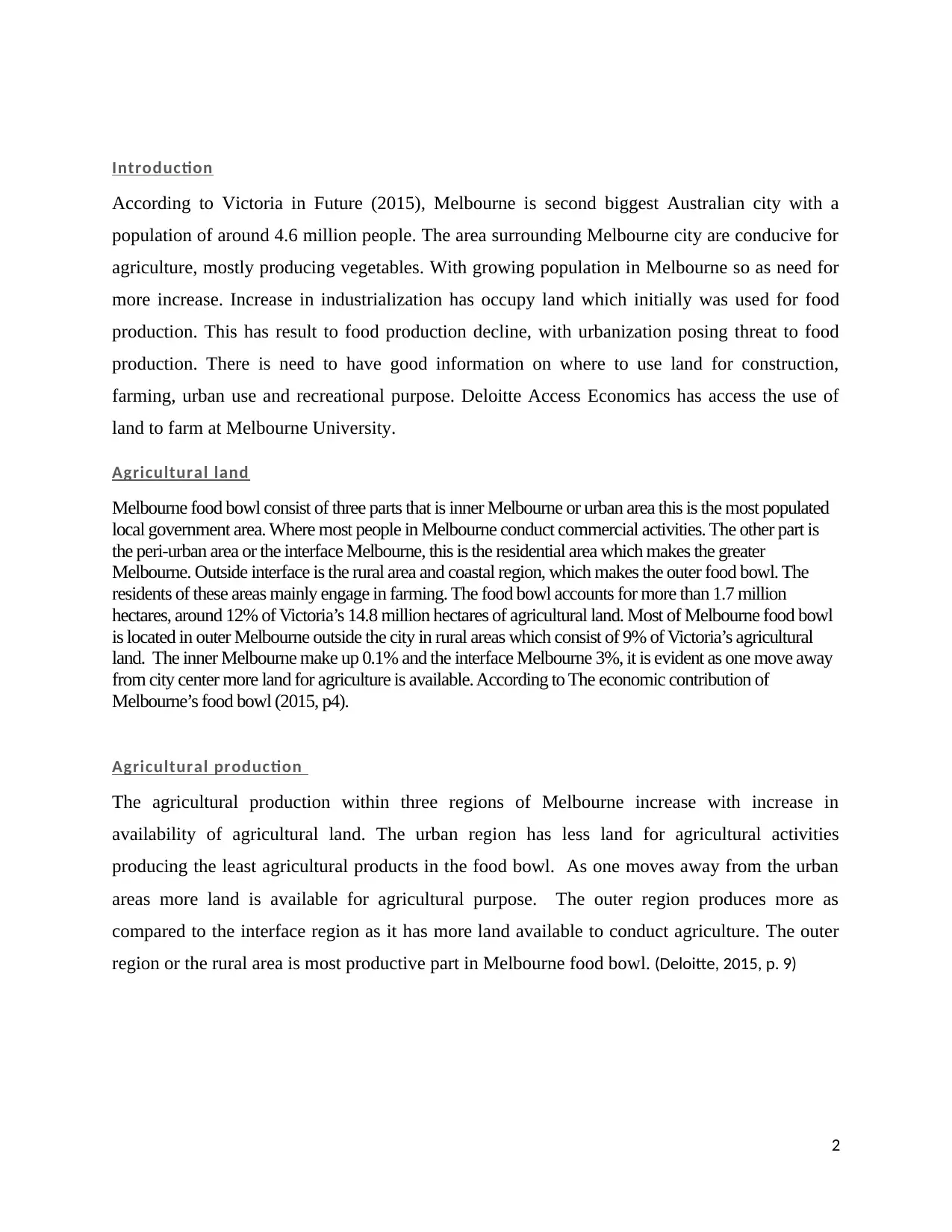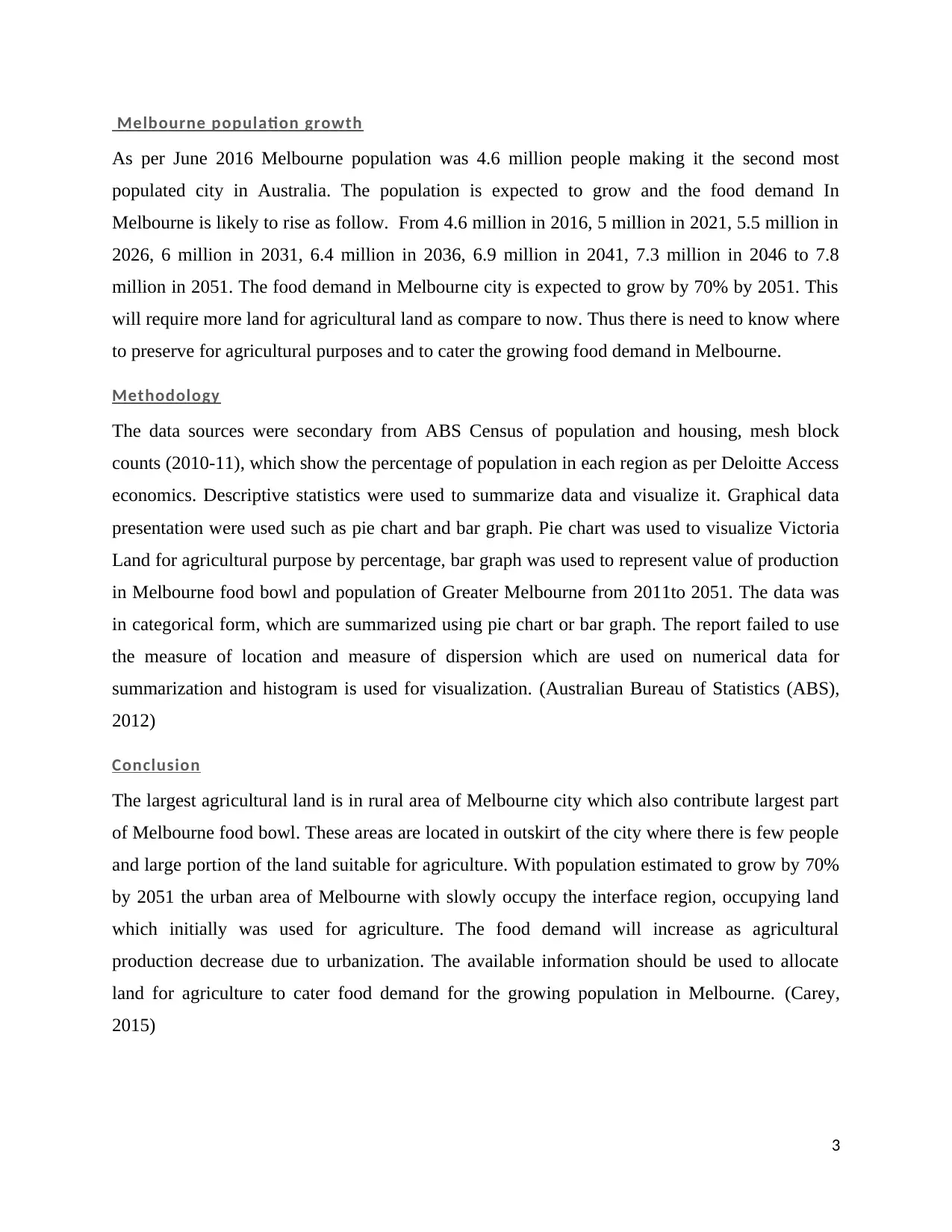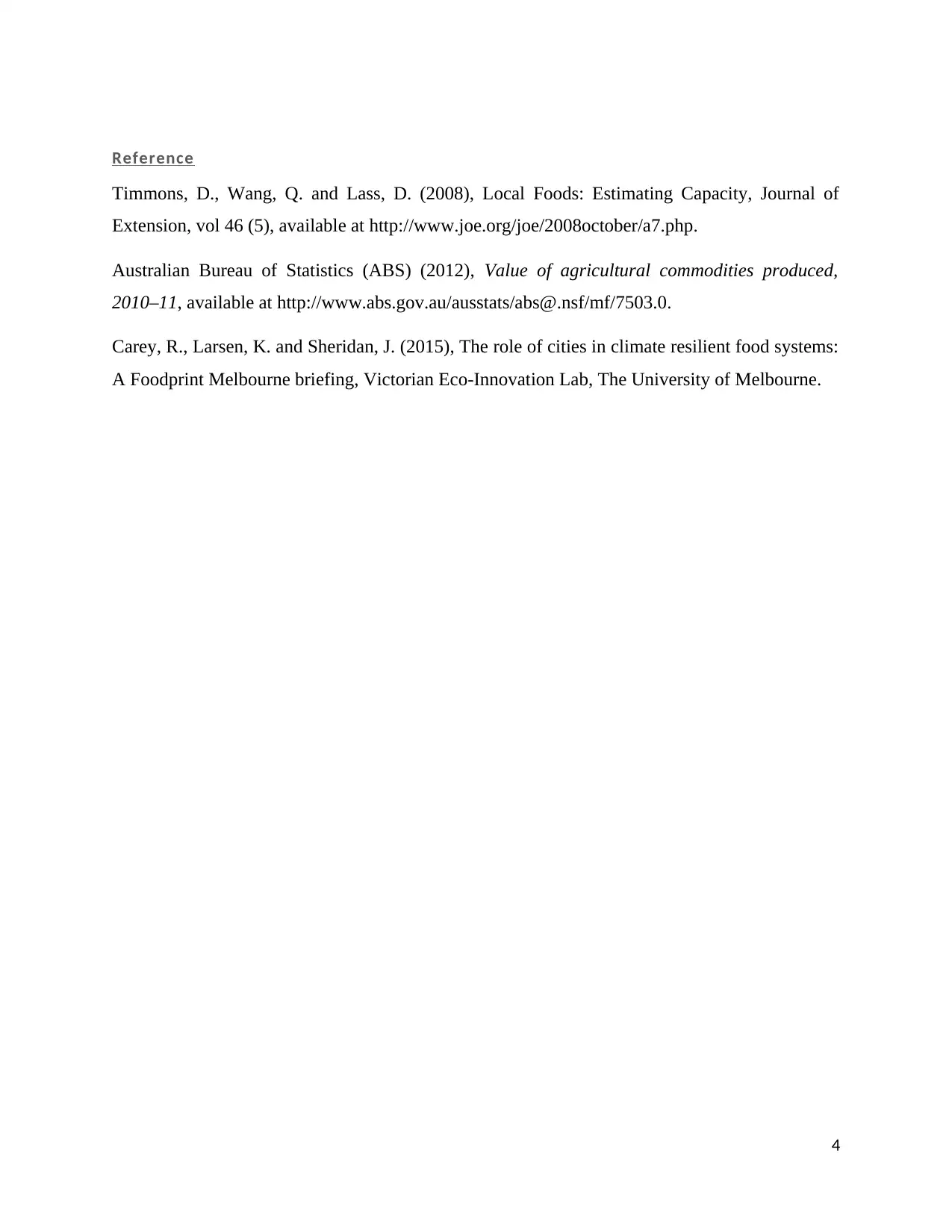Economic Contribution of Melbourne's Food Bowl
VerifiedAdded on 2020/03/02
|4
|936
|29
Report
AI Summary
This report analyzes the economic contribution of Melbourne's food bowl, highlighting the agricultural land distribution, production levels, and the impact of population growth on food demand. It discusses the need for sustainable land use to meet future food requirements as urbanization encroaches on agricultural areas.

The economic contribution of
Melbourne’s food bowl
Student name…
Student ID…
Unit name…
Unit code…
Assignment name…
Submission date…
Lecturer name…
Campus…
1
Melbourne’s food bowl
Student name…
Student ID…
Unit name…
Unit code…
Assignment name…
Submission date…
Lecturer name…
Campus…
1
Paraphrase This Document
Need a fresh take? Get an instant paraphrase of this document with our AI Paraphraser

Introduction
According to Victoria in Future (2015), Melbourne is second biggest Australian city with a
population of around 4.6 million people. The area surrounding Melbourne city are conducive for
agriculture, mostly producing vegetables. With growing population in Melbourne so as need for
more increase. Increase in industrialization has occupy land which initially was used for food
production. This has result to food production decline, with urbanization posing threat to food
production. There is need to have good information on where to use land for construction,
farming, urban use and recreational purpose. Deloitte Access Economics has access the use of
land to farm at Melbourne University.
Agricultural land
Melbourne food bowl consist of three parts that is inner Melbourne or urban area this is the most populated
local government area. Where most people in Melbourne conduct commercial activities. The other part is
the peri-urban area or the interface Melbourne, this is the residential area which makes the greater
Melbourne. Outside interface is the rural area and coastal region, which makes the outer food bowl. The
residents of these areas mainly engage in farming. The food bowl accounts for more than 1.7 million
hectares, around 12% of Victoria’s 14.8 million hectares of agricultural land. Most of Melbourne food bowl
is located in outer Melbourne outside the city in rural areas which consist of 9% of Victoria’s agricultural
land. The inner Melbourne make up 0.1% and the interface Melbourne 3%, it is evident as one move away
from city center more land for agriculture is available. According to The economic contribution of
Melbourne’s food bowl (2015, p4).
Agricultural production
The agricultural production within three regions of Melbourne increase with increase in
availability of agricultural land. The urban region has less land for agricultural activities
producing the least agricultural products in the food bowl. As one moves away from the urban
areas more land is available for agricultural purpose. The outer region produces more as
compared to the interface region as it has more land available to conduct agriculture. The outer
region or the rural area is most productive part in Melbourne food bowl. (Deloitte, 2015, p. 9)
2
According to Victoria in Future (2015), Melbourne is second biggest Australian city with a
population of around 4.6 million people. The area surrounding Melbourne city are conducive for
agriculture, mostly producing vegetables. With growing population in Melbourne so as need for
more increase. Increase in industrialization has occupy land which initially was used for food
production. This has result to food production decline, with urbanization posing threat to food
production. There is need to have good information on where to use land for construction,
farming, urban use and recreational purpose. Deloitte Access Economics has access the use of
land to farm at Melbourne University.
Agricultural land
Melbourne food bowl consist of three parts that is inner Melbourne or urban area this is the most populated
local government area. Where most people in Melbourne conduct commercial activities. The other part is
the peri-urban area or the interface Melbourne, this is the residential area which makes the greater
Melbourne. Outside interface is the rural area and coastal region, which makes the outer food bowl. The
residents of these areas mainly engage in farming. The food bowl accounts for more than 1.7 million
hectares, around 12% of Victoria’s 14.8 million hectares of agricultural land. Most of Melbourne food bowl
is located in outer Melbourne outside the city in rural areas which consist of 9% of Victoria’s agricultural
land. The inner Melbourne make up 0.1% and the interface Melbourne 3%, it is evident as one move away
from city center more land for agriculture is available. According to The economic contribution of
Melbourne’s food bowl (2015, p4).
Agricultural production
The agricultural production within three regions of Melbourne increase with increase in
availability of agricultural land. The urban region has less land for agricultural activities
producing the least agricultural products in the food bowl. As one moves away from the urban
areas more land is available for agricultural purpose. The outer region produces more as
compared to the interface region as it has more land available to conduct agriculture. The outer
region or the rural area is most productive part in Melbourne food bowl. (Deloitte, 2015, p. 9)
2

Melbourne population growth
As per June 2016 Melbourne population was 4.6 million people making it the second most
populated city in Australia. The population is expected to grow and the food demand In
Melbourne is likely to rise as follow. From 4.6 million in 2016, 5 million in 2021, 5.5 million in
2026, 6 million in 2031, 6.4 million in 2036, 6.9 million in 2041, 7.3 million in 2046 to 7.8
million in 2051. The food demand in Melbourne city is expected to grow by 70% by 2051. This
will require more land for agricultural land as compare to now. Thus there is need to know where
to preserve for agricultural purposes and to cater the growing food demand in Melbourne.
Methodology
The data sources were secondary from ABS Census of population and housing, mesh block
counts (2010-11), which show the percentage of population in each region as per Deloitte Access
economics. Descriptive statistics were used to summarize data and visualize it. Graphical data
presentation were used such as pie chart and bar graph. Pie chart was used to visualize Victoria
Land for agricultural purpose by percentage, bar graph was used to represent value of production
in Melbourne food bowl and population of Greater Melbourne from 2011to 2051. The data was
in categorical form, which are summarized using pie chart or bar graph. The report failed to use
the measure of location and measure of dispersion which are used on numerical data for
summarization and histogram is used for visualization. (Australian Bureau of Statistics (ABS),
2012)
Conclusion
The largest agricultural land is in rural area of Melbourne city which also contribute largest part
of Melbourne food bowl. These areas are located in outskirt of the city where there is few people
and large portion of the land suitable for agriculture. With population estimated to grow by 70%
by 2051 the urban area of Melbourne with slowly occupy the interface region, occupying land
which initially was used for agriculture. The food demand will increase as agricultural
production decrease due to urbanization. The available information should be used to allocate
land for agriculture to cater food demand for the growing population in Melbourne. (Carey,
2015)
3
As per June 2016 Melbourne population was 4.6 million people making it the second most
populated city in Australia. The population is expected to grow and the food demand In
Melbourne is likely to rise as follow. From 4.6 million in 2016, 5 million in 2021, 5.5 million in
2026, 6 million in 2031, 6.4 million in 2036, 6.9 million in 2041, 7.3 million in 2046 to 7.8
million in 2051. The food demand in Melbourne city is expected to grow by 70% by 2051. This
will require more land for agricultural land as compare to now. Thus there is need to know where
to preserve for agricultural purposes and to cater the growing food demand in Melbourne.
Methodology
The data sources were secondary from ABS Census of population and housing, mesh block
counts (2010-11), which show the percentage of population in each region as per Deloitte Access
economics. Descriptive statistics were used to summarize data and visualize it. Graphical data
presentation were used such as pie chart and bar graph. Pie chart was used to visualize Victoria
Land for agricultural purpose by percentage, bar graph was used to represent value of production
in Melbourne food bowl and population of Greater Melbourne from 2011to 2051. The data was
in categorical form, which are summarized using pie chart or bar graph. The report failed to use
the measure of location and measure of dispersion which are used on numerical data for
summarization and histogram is used for visualization. (Australian Bureau of Statistics (ABS),
2012)
Conclusion
The largest agricultural land is in rural area of Melbourne city which also contribute largest part
of Melbourne food bowl. These areas are located in outskirt of the city where there is few people
and large portion of the land suitable for agriculture. With population estimated to grow by 70%
by 2051 the urban area of Melbourne with slowly occupy the interface region, occupying land
which initially was used for agriculture. The food demand will increase as agricultural
production decrease due to urbanization. The available information should be used to allocate
land for agriculture to cater food demand for the growing population in Melbourne. (Carey,
2015)
3
⊘ This is a preview!⊘
Do you want full access?
Subscribe today to unlock all pages.

Trusted by 1+ million students worldwide

Reference
Timmons, D., Wang, Q. and Lass, D. (2008), Local Foods: Estimating Capacity, Journal of
Extension, vol 46 (5), available at http://www.joe.org/joe/2008october/a7.php.
Australian Bureau of Statistics (ABS) (2012), Value of agricultural commodities produced,
2010–11, available at http://www.abs.gov.au/ausstats/abs@.nsf/mf/7503.0.
Carey, R., Larsen, K. and Sheridan, J. (2015), The role of cities in climate resilient food systems:
A Foodprint Melbourne briefing, Victorian Eco-Innovation Lab, The University of Melbourne.
4
Timmons, D., Wang, Q. and Lass, D. (2008), Local Foods: Estimating Capacity, Journal of
Extension, vol 46 (5), available at http://www.joe.org/joe/2008october/a7.php.
Australian Bureau of Statistics (ABS) (2012), Value of agricultural commodities produced,
2010–11, available at http://www.abs.gov.au/ausstats/abs@.nsf/mf/7503.0.
Carey, R., Larsen, K. and Sheridan, J. (2015), The role of cities in climate resilient food systems:
A Foodprint Melbourne briefing, Victorian Eco-Innovation Lab, The University of Melbourne.
4
1 out of 4
Related Documents
Your All-in-One AI-Powered Toolkit for Academic Success.
+13062052269
info@desklib.com
Available 24*7 on WhatsApp / Email
![[object Object]](/_next/static/media/star-bottom.7253800d.svg)
Unlock your academic potential
Copyright © 2020–2025 A2Z Services. All Rights Reserved. Developed and managed by ZUCOL.





